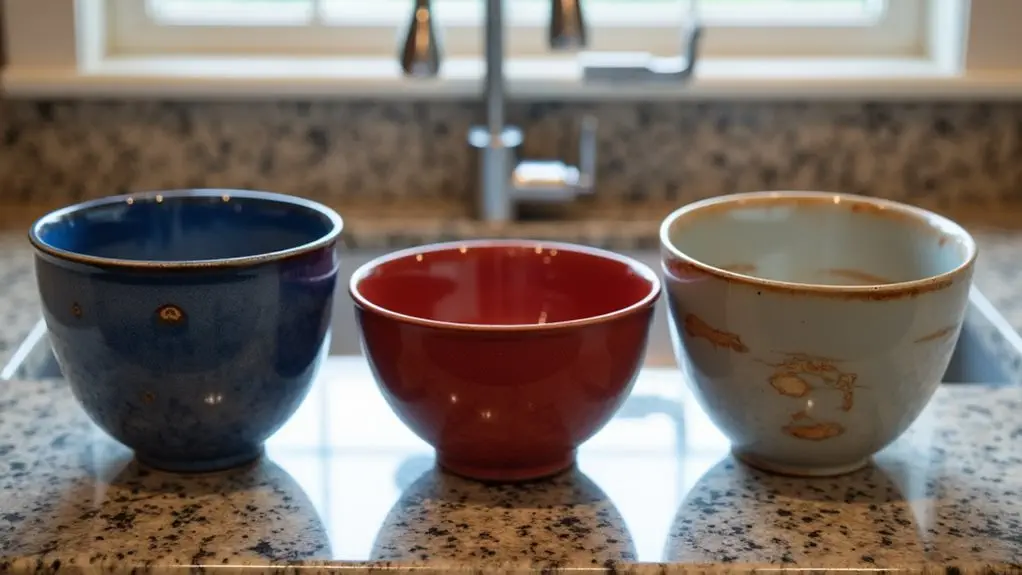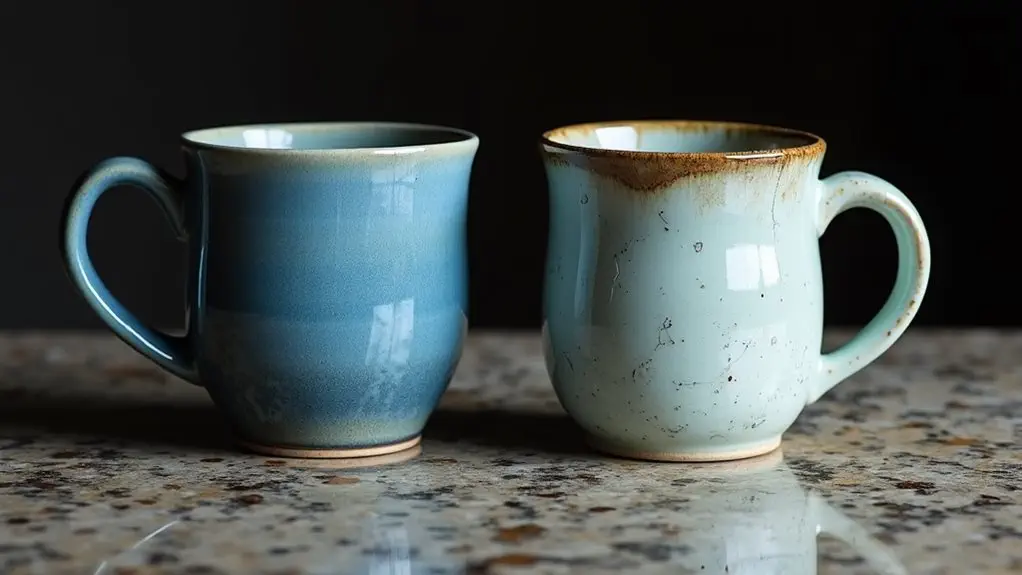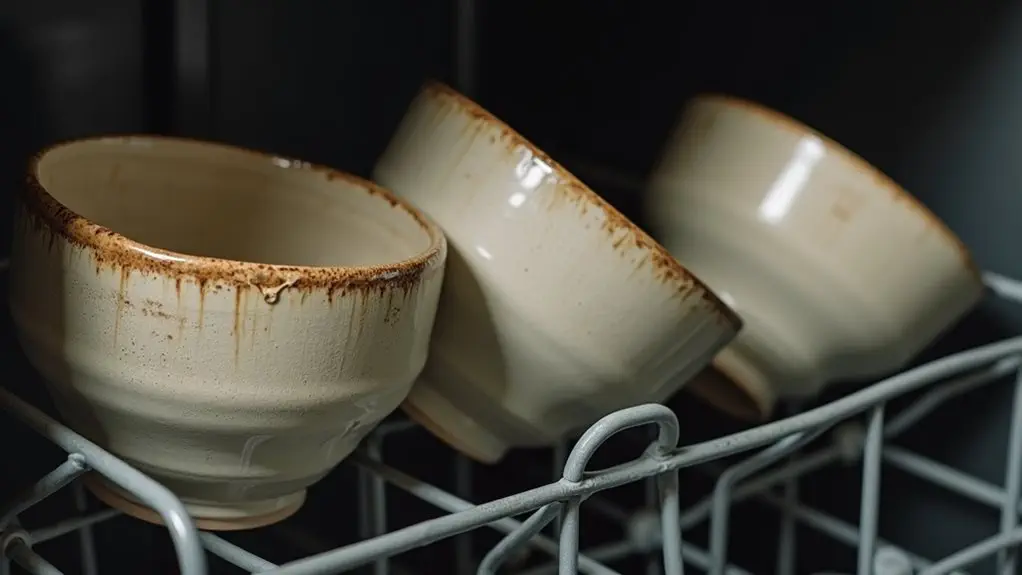While some handmade pottery can go in the dishwasher, you'll want to check a few key things first. Stoneware and vitrified pottery are typically dishwasher-safe, but earthenware and delicate pieces should be hand-washed. Look for dishwasher-safe symbols (usually a square box with plates) or explicit labeling on the bottom. If you do use the dishwasher, place items securely with proper spacing, use the gentle cycle, and opt for mild detergents to protect the glaze. When in doubt, hand washing with warm water and gentle soap is your safest bet. There's plenty more to reflect on when caring for your cherished pottery pieces.
Understanding Pottery Types

While pottery comes in several varieties, knowing the key differences between earthenware, stoneware, ball clay, and porcelain can help you determine which pieces are dishwasher-safe.
Each type's clay properties affect how it'll handle the heat and moisture in your dishwasher. Earthenware's porous nature makes it risky for machine washing, while stoneware's durability makes it your best bet for everyday use. The beauty of stoneware lies in its natural water resistance, making it an excellent choice for frequent washing. For fine pieces like the Ethereal Swirl Miniature Vase, be cautious with dishwasher use to maintain its exquisite finish.
If you're exploring pottery techniques, you'll find that ball clay pieces depend on their blend composition for dishwasher safety.
And while those elegant porcelain pieces might look delicate, they can actually handle your dishwasher – just be careful with their fragile nature.
Understanding these differences isn't just about preserving your pottery; it's about protecting your creative investment and ensuring your pieces last longer.
Recognizing Dishwasher Safe Symbols
Ever wondered what those tiny symbols on your dishes really mean? When it comes to dishwasher symbols and safety guidelines, they're your secret code to protecting your favorite pieces.
Look for a square box with diagonal lines – that's your green light for dishwasher use. Some variations may include plates and glasses sketched inside the box design. You'll often find it on the bottom, sides, or handle of your items.
For plastics, check for those recycling triangles with numbers 1, 2, 4, or 5 – these are typically dishwasher-friendly on the top rack. Some items might spell it out with "dishwasher safe" text instead of symbols.
If you're unsure, just flip through the original packaging or manual. Can't find any symbols? It's better to play it safe and hand wash. Your dishes will thank you for taking the time to decode their care instructions!
Glaze Matters

Understanding symbols is just the start – the glaze on your pottery tells an equally important safety story.
When considering glaze types and glaze durability, you'll want to focus on pieces fired at higher temperatures, like stoneware and porcelain, which typically handle dishwasher conditions better. For instance, handcrafted items, such as a Blue & White Porcelain Ring holder, often feature unique, durable glazes that can withstand washing.
Your pottery's glaze should be food-safe and chemically stable – think of it as your dish's protective shield against those harsh dishwasher detergents. Non-abrasive cleaners are essential for preserving your pottery's glaze over time.
If you've got pieces with special decorative elements like gold luster or Mother of Pearl, you'll want to show them some extra TLC with hand washing. The exquisite craftsmanship of handmade items often requires a delicate approach to cleaning.
For everyday pieces, look for vitrified pottery that's been fired at high temperatures – these are your kitchen warriors that'll stand up to regular dishwasher cycles.
Just remember, even the toughest glazes prefer gentler detergents to help them maintain their beautiful finish.
Temperature and Thermal Shock
Temperature changes pose the biggest threat to your pottery's survival in the dishwasher, as sudden shifts from hot to cold can trigger thermal shock.
Think of it like jumping into an ice-cold pool on a scorching day – not fun for you, and definitely not fun for your pottery! Your handmade pieces can develop thermal stress when exposed to rapid temperature changes, potentially leading to cracks or breaks.
To protect your pottery, you'll want to focus on temperature regulation throughout the cleaning process. Stoneware pieces are typically fired at high temperatures between 1800-2300°F, making them durable but still susceptible to thermal shock.
If you're using the dishwasher, run it on a gentle cycle that won't create dramatic temperature swings.
Even better, let your pottery cool naturally after the wash cycle ends – don't open the door right away. This gives your pieces time to adjust gradually, just like they prefer it.
Common Dishwasher Risks

When you're loading pottery into your dishwasher, you'll need to watch out for temperature shock that can crack your favorite pieces.
Your dishwasher's intense heat and harsh detergents can wear down protective glazes over time, making your cherished items more vulnerable to damage. Using dishwasher-specific detergents is essential to prevent excessive suds that could further compromise your pottery's finish.
Items bumping against each other during the wash cycle can chip or break your pottery, so it's smart to space them well apart and secure them properly in the racks.
Temperature Shock Damage
Placing pottery in your dishwasher can lead to devastating temperature shock damage, especially for vulnerable pieces like earthenware and low-fire clays. When you expose these items to rapid temperature changes during wash cycles, you're creating thermal stress that can turn your favorite mug into a cracked mess overnight.
You'll want to be extra careful with pieces that have a porous surface or those beautiful handmade items fired at lower temperatures. These ceramics are particularly susceptible to temperature shock because they absorb water and expand unevenly when heated. Gradual heating is essential for preventing thermal shock damage in pottery pieces.
Instead of risking your cherished pottery collection, opt for hand washing your vulnerable pieces. If you're unsure whether your pottery can handle the dishwasher, look for signs like a porous surface, raku firing, or metallic glazes – these are your red flags for hand-wash-only items.
Glaze Wear Concerns
Your cherished pottery's glaze faces significant risks in the dishwasher due to harsh detergent chemicals and repeated wash cycles.
Common detergents containing phosphates and triclosan can slowly deteriorate even the most durable glazes, leading to a dull, worn appearance over time. Pieces with gold lustre accents require extra caution, as they can be particularly vulnerable to dishwasher damage.
Everyday ceramics and thick, shiny surfaces generally withstand dishwasher conditions better than decorative pieces.
While high-fire porcelain and stoneware offer better glaze durability, they're not immune to dishwasher damage.
You'll want to be especially careful with pieces featuring special finishes like gold luster or Mother of Pearl – these should never see the inside of your dishwasher.
For ideal dishwasher maintenance and pottery preservation, always check for the dishwasher-safe symbol underneath your pieces.
When in doubt, handwashing is your safest bet.
Pottery Bumping Hazards
Inside a running dishwasher, pottery pieces can jostle against each other and the rack's metal tines, creating significant risks for your cherished ceramics.
For effective bumping prevention, you'll want to pay special attention to pieces with delicate details or intricate designs, as they're particularly vulnerable to damage from unexpected collisions. The Squiggles and Dots Porcelain Ring Holder, with its delicate features and gentle curves, exemplifies this vulnerability.
Washing at milder temperatures around 100°F or 38°C through handwashing is far gentler on pottery than dishwasher cycles.
To master collision avoidance, start by securing each piece with enough space between them – think of it as creating a safety bubble around your pottery.
If you've got handmade items or ceramics with fine sculptural elements, you might want to skip the dishwasher altogether. Remember that the meticulous craftsmanship of handmade ceramics contributes to their unique appeal, so it's wise to protect your investment.
And here's a pro tip: those beautiful porcelain pieces with metallic lusters or decals? They're best friends with hand-washing, as they'll stay pristine longer away from the rough-and-tumble dishwasher environment.
Proper Loading Techniques
Three fundamental principles guide proper dishwasher loading: secure placement, adequate spacing, and protection of delicate items.
Your loading strategies should prioritize stability to prevent your pottery from dancing around during the wash cycle. Secure placement means ensuring each piece has its own space and isn't likely to bump against neighboring items.
For ideal results, you'll want to place larger, sturdier pieces along the sides and back of your dishwasher, while keeping more delicate items toward the center where there's less water pressure. Regular dishwasher use can lead to increased wear on ceramics over time.
Don't try to squeeze too many pieces in – your pottery needs room to breathe! If you've got pieces with special finishes or delicate decorations, it's best to hand wash those instead.
Hand Washing Best Practices

While dishwashers offer convenience, proper hand washing techniques remain essential for preserving your pottery's beauty and longevity.
When it comes to pottery maintenance, you'll want to use warm water with mild detergent and a soft sponge or brush – think gentle care, not aggressive scrubbing! Regular inspections during cleaning help identify any chips or cracks early on.
Skip those metal brushes and abrasive scouring pads that might seem tough on dirt but can wreak havoc on your ceramics.
You'll also want to pay attention to temperature – sudden changes can shock your pottery, so keep it consistent.
After washing, dry your pieces with a soft cloth and store them in a cool, dry place.
For earthenware and unglazed stoneware, you'll definitely want to stick to hand washing. It's like giving your pottery a spa day – treating it with care now means you'll enjoy its beauty for years to come.
Preserving Decorative Elements
Taking proper care of decorated pottery requires understanding what can and can't go in your dishwasher. When it comes to decorative fragility, you'll want to be especially careful with pieces featuring special glazes like gold luster or Mother of Pearl. These delicate elements can quickly deteriorate under harsh dishwasher conditions.
Your cleaning techniques should match your pottery's specific needs. While stoneware's typically dishwasher-safe, those beautiful handmade pieces with exposed clay or intricate designs deserve gentle hand washing. Multiple thin coats of sealant may not adequately protect decorative elements.
You wouldn't want your favorite pottery piece losing its charm in the dishwasher! Pay attention to embedded materials and non-flat designs – they're particularly vulnerable to damage.
If you're unsure about a piece, look for that handy dishwasher-safe symbol (it looks like water drops over a plate), or better yet, contact your potter for guidance.
Types of Safe Detergents

When choosing a detergent for your cherished ceramics, you'll want to skip those harsh, industrial-strength cleaners that can really do a number on your pieces.
You can protect your pottery by sticking with gentle, phosphate-free detergents that won't strip away the glaze or harm decorative elements.
If you're looking for natural alternatives, vinegar-based cleaners or eco-friendly dish soaps work wonderfully and will keep your ceramics looking their best.
Regular use of harsh detergents can gradually deteriorate your pottery's surface over time.
Gentle Vs Harsh Cleaners
Choosing the right dishwasher detergent can make or break the safety of your pottery and ceramics. While you'll find plenty of options on store shelves, not all are created equal when it comes to protecting your cherished pieces.
Gentle detergents, particularly liquid or gel formulas, are your best friends for delicate pottery. They're water-based and offer better control over how much you're using, which helps prevent damage to your pieces. These detergents are designed with liquid surfactants that dissolve quickly in water, making them gentler on your items.
On the flip hand, harsh detergents like powder cleaners with bleach or enzyme-packed pods can be your pottery's worst nightmare. They're often too concentrated and can etch or deteriorate your ceramics over time.
If you're dealing with handmade pieces or items with special glazes, stick to mild, liquid detergents that don't contain bleach or aggressive cleaning agents.
Natural Detergent Alternatives
For those seeking safer dishwashing solutions, natural detergent alternatives offer both eco-friendly and pottery-safe options.
You'll find several innovative brands that prioritize natural ingredients while delivering effective cleaning power. Blueland and Grove Collaborative lead the way with their plastic-free packaging and plant-based formulas, while Tropical Traditions offers an enzyme-based cleaner that's gentle yet thorough. High humidity storage can affect some natural detergents' consistency.
If you're feeling adventurous, you can try making your own dishwasher detergent, though be prepared for possible residue issues.
For more reliable eco-friendly options, consider Ecover Powder or Mrs. Myers – they're readily available at local stores and won't break the bank.
These natural alternatives not only protect your pottery but also help reduce your environmental impact, making them a win-win for both your dishes and the planet.
Signs of Dishwasher Damage
Recognizing the signs of dishwasher damage early can save you from costly repairs and potential water damage to your home.
When you're identifying wear in your dishwasher, pay attention to these key dishwasher maintenance tips that'll help you spot trouble before it escalates. With the typical lifespan of 9-10 years, knowing when your appliance is declining becomes crucial.
- Watch for unusual noises during cycles – grinding, rattling, or buzzing sounds aren't your dishwasher's way of singing!
- Check for standing water at the bottom after each cycle, which often signals a clogged drain or failing pump.
- Look for visible damage like cracks, rust spots, or worn-out seals that might lead to leaks.
- Monitor your dishes' cleanliness – if they're coming out spotty or with food particles stuck on them, your dishwasher's probably crying for help.
Don't ignore these warning signs – they're your appliance's way of asking for attention.
Final Thoughts
Want to keep your cherished handmade pottery looking beautiful for years to come? While it's tempting to toss everything in the dishwasher, your handmade pieces deserve special care. By following proper cleaning methods, checking glaze types, and paying attention to temperature sensitivities, you'll protect your pottery from damage. When in doubt, hand washing with gentle detergent remains your safest bet – it's worth those extra few minutes to preserve your ceramic treasures.




